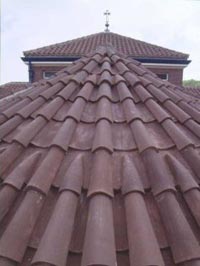Ecclesiastical architect is remembered with bespoke restoration project
 The unusual roof of a Byzantine-style church built in Sheffield by renowned ecclesiastical architect Adrian Gilbert Scott (1882-1963) has been restored in a painstaking project requiring all the tiles to be specially made by hand.
The unusual roof of a Byzantine-style church built in Sheffield by renowned ecclesiastical architect Adrian Gilbert Scott (1882-1963) has been restored in a painstaking project requiring all the tiles to be specially made by hand.
As a Grade II listed building of great historical and aesthetic significance, it was important that the roof, which had fallen into a state of disrepair, be restored to the curious specifications laid down by Gilbert Scott himself in 1932.
However, due to its unusual shape, this was far from straightforward and a great deal of expertise and not a little ingenuity was needed in crafting the clay tiles used in the restoration.
When it came to the roof of the Roman Catholic Church of Our Lady of Beauchief & Saint Thomas of Canterbury, Gilbert Scott, who travelled widely, chose roof tiles more reminiscent of the Rhone than the Don.
Architect Anthony Tranmer of John Rochford & Partners explains: “The roof is very special as it is an ‘over and under’ clay tile roof, which is unusual in Sheffield, where slate tiles are more frequently used. In fact this style is quite rare in the UK as a whole, being more typical of church architecture in southern Europe.
“The shape of the roof is also unusual as it diminishes rapidly on the apsidal ends. Therefore special care had to be taken to ensure that the new tiles were fitted correctly.”
The church was awarded Grade II status in recognition of the importance of Adrian Gilbert Scott in the history of 20th century church architecture in Britain.
The Gilbert Scotts are the most famous dynasty of church architects of England in the last 200 years. Adrian and his more celebrated brother Sir Giles Gilbert Scott (1880 – 1960) worked on many projects throughout Britain and abroad. Their grandfather, Sir George Gilbert Scott (1811 – 1878) and father, George Gilbert Scott (1839 – 1897) were both ecclesiastical architects.
The most important collaborative works of the brothers include the construction of the UK’s largest cathedral — Liverpool Cathedral, which Giles designed when he was just 22 and the rebuilding of the House of Commons after the second world war.
The architectural importance of Our Lady of Beauchief & Saint Thomas of Canterbury’s Church is such that a heritage lottery fund was granted for almost 70 per cent of the cost of the restoration, with the remainder funded by the church and the diocese.
Anthony Tranmer added: “It was immediately apparent that the roof would require specialist attention and that handmade tiles would have to be used to allow for its shape. As a result we contacted the heritage service of Sandtoft Roof Tiles because of their experience in ecclesiastical and heritage projects.”
One of the most unusual aspects of the restoration is that, due to the diminishing slope on the apsidal ends Sandtoft had to create a completely new style of tile — with wings — in order to restore the roof and maintain its original appearance. The innovative tiles were also crucial to ensure that the new roof remains watertight.
Sandtoft’s Nigel Dyer, who worked closed with Anthony Tranmer, said: “We describe the tile as having angels’ wings and it is unlike anything we have created before. The main body of the tile is cone shaped with panels — or wings —attached on either side. We made 36 of these tiles in three different sizes to complete the roof, although every one of the 190 tiles for this section, had to be custom-made and all the tiles on the roof were hand-made.”
Six weeks were spent designing the special ‘winged’ tiles, as it was essential that all the tiles fit precisely first time to prevent any water damage to the fabric of the church. To ensure that no mistakes were made Sandtoft took the precaution of creating a replica section of the roof to test the fit of the new tiles.
In keeping with the colour of the original roof, all the tiles were supplied in a Dark Chestnut sanded clay colour.
Parish priest Father John Metcalfe said: “I am thrilled that the history and heritage of this beautiful church building have been maintained. The church is of great significance to the local Roman Catholic community. In wider terms it also has considerable architectural importance.”
Anthony Tranmer concluded: “The care and attention that all involved have contributed to this project is a great tribute to the work of Adrian Gilbert Scott.”
For further information visit www.sandtoft.com















